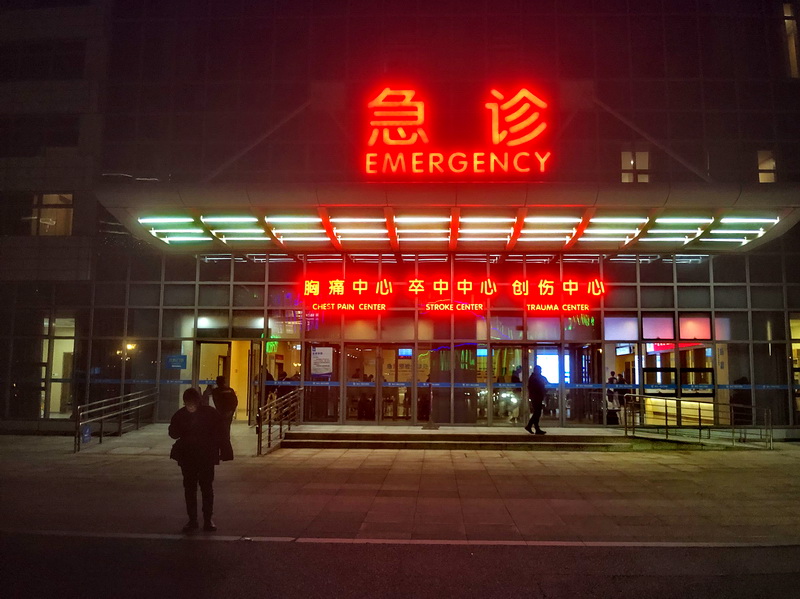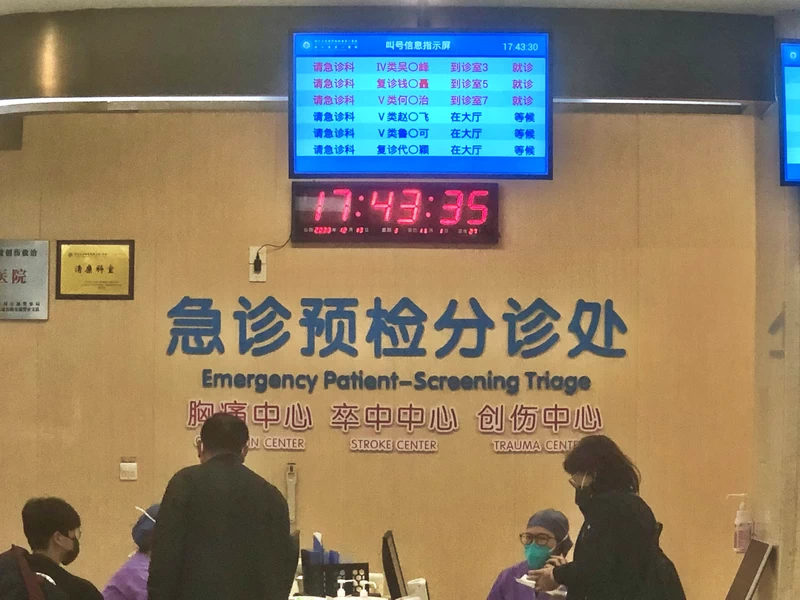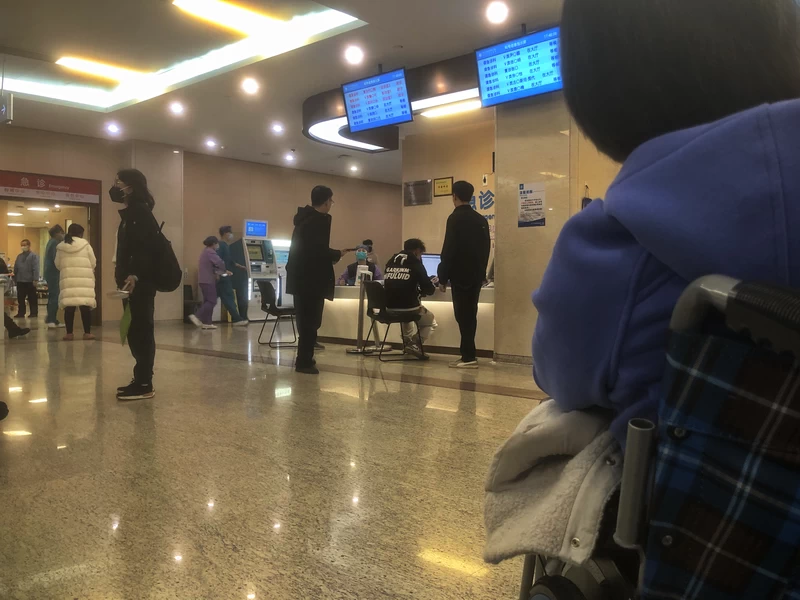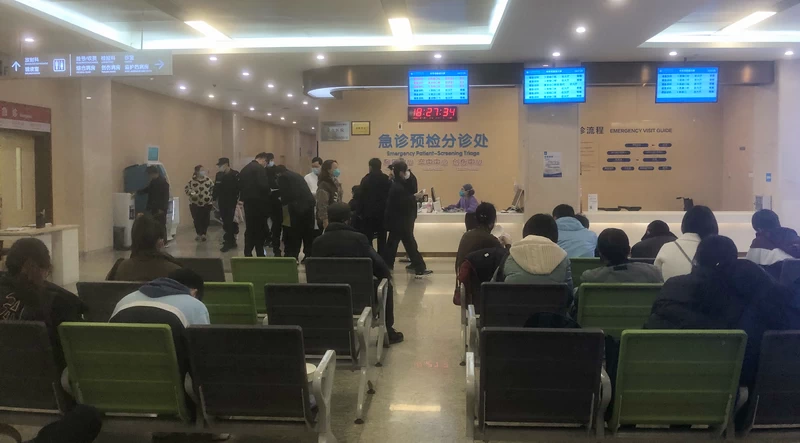A few days ago, my cellphone rang. It was my wife calling from Lijiang, a poetic old town in Yunnan Province in the landlocked southwest China. She was on her solo trip there. She told me that she had her right ankle broken and she got the disappointing result after X-rayed in a local hospital, and she would fly back to Hangzhou for further medications next day, an almost 3 hours’ flight.
The next later afternoon, waiting outside the exit at T4 (the terminal no.4 building) in Hangzhou Xiaoshan International Airport, later I saw my wife sitting in a wheelchair pushed by an airport employee. I thanked the airport worker who took back the wheelchair and went inside, which left my wife using her own trekking pole hopping to the elevator, not far away down the B1 where my car parked, while I carried her suitcase walking slowly along with her.
She crouched herself onto the back seat of the car, sitting there with her right foot lying on the seat to keep her right ankle in a straight position. Guided by Gaode Map (a professional navigation platform with accurate data in China), I started my car, driving out of the parking garage at the airport and then went to Zhijiang Campus of the First Affiliated Hospital, Zhejiang University School of Medicine (FAHZH Campus).

When we got to the emergency department, it was almost dark outside. One of the security guides kindly reminded me using my smartphone app to rent a wheelchair in the room at the entrance with a row of wheelchairs inside. Hangzhou is one of the best digitalised cities in China, of which I’m very much proud. I used my phone scanning the barcode and easily took out the locked wheelchair, with the first 120 minutes free and 3 yuan for each hours added.

I pushed my wife in the wheelchair, and we went directly up to the triage counter. One of the nurses attended to us listening patiently to my wife explaining her situation from beginning to the end. Then she had my wife registered and asked us to wait in the emergency waiting hall and watch the digital call waiting display screen, waiting to be called to the clinic room.
To my surprise, there were quite lots of people in the waiting hall, sitting on the rows of chairs patiently waiting to be called to their clinic rooms, hence the joke to the effect that the “best and prosperous business” in China belongs to hospitals.

At Clinic Room No.5, Dr. Wu took care of my wife. My wife unbounded her wrap on her right ankle. Dr. Wu looked at the ankle and checked the X-ray taken at the Lijiang Hospital, reconfirming the diagnosis of my wife’s fractured right ankle, or specifically, her outer ankle bone ( fibula) was broken.
He asked us to do the CT scanning to get rid of the possibility of the dislocation of the three bones in the ankle since my wife’s three hours’ flight and other activities might cause the misalignment of her right ankle after the X-ray in Lijiang.
So, we left the Clinic Room 5 and went to the Radiology Department on the same first floor for the CT scan. After the CT scan, we again waited in the waiting hall for the digital call waiting display screen to be called for revisiting the Clinic 5 while waiting for the result of the diagnostic imaging by checking the machine standing in the waiting hall at the Emergency Department.
One hour after the CT scan, we were again at the Clinic 5 to be attended to by Dr. Wu. We breathed a sigh of relief when Dr. said that my wife’s right ankle was not misaligned, and we could have the choice of non-surgical treatment with 3 weeks’ homestay and then come back for MRI.
Dr. Wu suggested a non-surgical treatment and told us to go up to the emergency room at the Department of
Orthopaedic for casting on the second floor. He advised my wife to stay at home for 3 weeks and then come back for further diagnosis. He also requested us to come back tomorrow to see the doctor in Department of Orthopaedic to reconfirm the diagnosis.
On the same evening, at Department of Orthopaedic, a female technician molded a cast per my wife’s right foot, immobilizing the ankle to keep it completely still during the healing process. She advised my wife to elevate the ankle (above the heart) and Ice the swollen area every one to two hours for 15 minutes at a time.
Back home, I ordered a wheelchair from Jingdong (JD.com), my favorite online shopping platform while my wife lied on her bed using her smartphone App to register the medical clinic online at Department of Orthopaedic at FAHZH Campus for the next afternoon.
The ordered wheelchair delivered in time, just one hour earlier before we left for the hospital. A big thanks to Jingdong! It was a 15 km’s drive from our home to FAHZH Campus. All the parking areas were fully packed, and we had to park our car in the basement garage, a double layered parking ( Double Stacker). I don’t like this kind of the double-layer automated parking garage.
I pushed my wife in the wheelchair walking to the building for the Outpatient Department. My wife used her smartphone to do all the procures and got a barcode to be scanned by the call waiting system screen hung on the wall in the waiting room at the Department of Orthopedic on the second floor.
At Clinic Room 1, Dr. Zhang treated my wife, checking the CT imaging done last night from his computer. He also showed the enlarged imaging by turning the screen to us explaining the location of the broken bone in the right ankle.
A little different from what Dr, Wu said last night, Dr. Zhang gave us two choices – either non-surgical or surgical, letting us to choose. The surgical treatment, a kind of minimally invasive surgery would fasten the treatment while the conservative (non-surgical) treatment would take 6 weeks normally for the total recovery.
I said to Dr. Zhang that we preferred the non-surgical treatment since my wife also suffered from the chronic ITP (Immune thrombocytopenic purpura). Basically minimally invasive surgery uses smaller surgical cuts, and most often is less risky than open surgery. But even with minimally invasive surgery, there are risks of complications with medicines that put you in a sleep-like state during surgery, bleeding and infection (from mayoclinic.org).
Now my wife is on her 6 weeks’ long trip to the recovery. I work as a house husband taking care of her three meals and other chores.
I’m very proud of my home town, Hangzhou, a highly developed and digitalized city.
Note: The 2016 G20 Hangzhou summit was the eleventh meeting of the Group of Twenty (G20). It was held on 4–5 September 2016 in the city of Hangzhou. The 19th Asian Games was held in Hangzhou 23 September – October 08, 2023.

